


JAMES COOK 1728 -
xxxxxThe English navigator James Cook was one of the greatest explorers of all time, famous not only for the extent of his discoveries and the quality of his seamanship, but also for his enlightened leadership. He took part in the naval operations which assisted in the capture of Quebec in 1759, and then commanded three voyages to the Pacific. During his first expedition (1768-
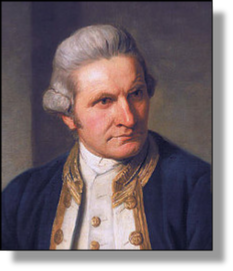 xxxxxThe British naval captain and navigator James Cook, the greatest explorer of the 18th century, spent a good half of his service in North American coastal waters, but he is remembered today for his three voyages to the Pacific Ocean. These expeditions took him from the Bering Strait to the ice fields of the Antarctic, and from Australia and New Zealand to the scattered islands of the South Seas and southern Atlantic. Few mariners have matched his contribution to navigation, cartography and discovery, and few have equalled him in courage, determination and quality of leadership.
xxxxxThe British naval captain and navigator James Cook, the greatest explorer of the 18th century, spent a good half of his service in North American coastal waters, but he is remembered today for his three voyages to the Pacific Ocean. These expeditions took him from the Bering Strait to the ice fields of the Antarctic, and from Australia and New Zealand to the scattered islands of the South Seas and southern Atlantic. Few mariners have matched his contribution to navigation, cartography and discovery, and few have equalled him in courage, determination and quality of leadership.
xxxxxCook was born in Marton, Yorkshire, the son of a Scottish farm labourer who had settled in England. On leaving school at the age of 12, he worked on the land for a while and then, at the age of 18, was apprenticed to a Whitby ship-
xxxxxThe first twelve years of his service were mostly spent in the North Atlantic. During the Seven Year's War he saw action in the Bay of Biscay, and then took part in the naval operations against the French in North America. Here, by his survey of the channel of the St. Lawrence River, he contributed to the successful attack upon Quebec, achieved by the climbing of the Abraham Heights further down stream. After the war he surveyed the coastal waters of Labrador, Newfoundland and Nova Scotia, and such was the accuracy of his charts that they were published for general use.
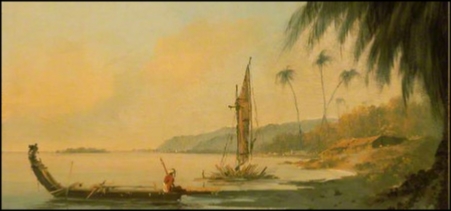 xxxxxIn August 1768, as lieutenant in charge of the Endeavour, a sturdy Whitby collier, he was given command of a scientific expedition to Tahiti in the South Pacific to observe Venus eclipsing the Sun, a rare phenomenon. Organised by the Royal Society, he had on board some artists, an astronomer (Charles Green), and two botanists, Joseph Banks and Daniel Solander. Having reached Tahiti (illustrated) and successfully witnessed the eclipse in June 1769, he then set out to find Terra Australis Incognita, an unknown continent thought to be situated further south. He passed through the Society Islands and then, sailing southwards, sighted New Zealand, first discovered by the Dutch navigator Abel Tasman in 1642. He spent several months surveying both islands, chartering and mapping some 2,400 miles of coastline and making a number of landings, the first being at Poverty Bay on the east coast of North Island where the Maoris were somewhat hostile.
xxxxxIn August 1768, as lieutenant in charge of the Endeavour, a sturdy Whitby collier, he was given command of a scientific expedition to Tahiti in the South Pacific to observe Venus eclipsing the Sun, a rare phenomenon. Organised by the Royal Society, he had on board some artists, an astronomer (Charles Green), and two botanists, Joseph Banks and Daniel Solander. Having reached Tahiti (illustrated) and successfully witnessed the eclipse in June 1769, he then set out to find Terra Australis Incognita, an unknown continent thought to be situated further south. He passed through the Society Islands and then, sailing southwards, sighted New Zealand, first discovered by the Dutch navigator Abel Tasman in 1642. He spent several months surveying both islands, chartering and mapping some 2,400 miles of coastline and making a number of landings, the first being at Poverty Bay on the east coast of North Island where the Maoris were somewhat hostile.
xxxxxThen, having made claim to territory on both islands, the expedition sailed west and discovered the unexplored coast of eastern Australia. Determined as ever to map uncharted waters, he then sailed northwards, surveying about 2,000 miles of the coastline. It was during this voyage that, in 1770 he landed in Australia for the first time, naming the place Botany Bay and claiming the area as New South Wales -
xxxxxApart from being highly successful both as a scientific venture and a voyage of discovery, the expedition was significant for a vital medical reason. By insisting on attention to cleanliness, and including cress, sauerkraut and citrus fruit in the ship's daily food, Cook did not lose a single man from scurvy, the scourge of mariners for centuries. As we have seen, pioneer work in treating this disease had been done by the Scottish naval surgeon James Lind in 1754 (G2). Cook was one of the first naval officers to put his advice into practice.
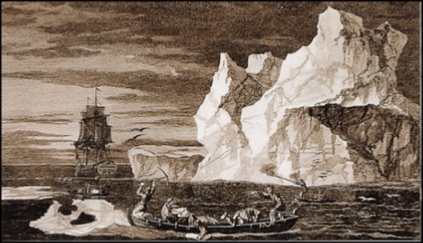 xxxxxThe Admiralty being as determined as ever to discover the elusive, so called "southern continent", a year later Cook was sent out again to the South Seas. He commanded the Resolution and was accompanied by the Adventure. So much scientific data had been collected during the first voyage that, once again, scientists and artists went along. Having rounded the Cape of Good the expedition headed south, making the first crossing of the Antarctic Circle in January 1773. Soon, however, sailing conditions became extremely hazardous, with stormy seas and the presence of gigantic ice floes. There being no sign of land, Cook turned to the east and made for New Zealand and the warmer waters of the South Pacific. It was here that the two vessels became separated and the Adventure returned to England, becoming the first vessel to circumnavigate the globe from west to east.
xxxxxThe Admiralty being as determined as ever to discover the elusive, so called "southern continent", a year later Cook was sent out again to the South Seas. He commanded the Resolution and was accompanied by the Adventure. So much scientific data had been collected during the first voyage that, once again, scientists and artists went along. Having rounded the Cape of Good the expedition headed south, making the first crossing of the Antarctic Circle in January 1773. Soon, however, sailing conditions became extremely hazardous, with stormy seas and the presence of gigantic ice floes. There being no sign of land, Cook turned to the east and made for New Zealand and the warmer waters of the South Pacific. It was here that the two vessels became separated and the Adventure returned to England, becoming the first vessel to circumnavigate the globe from west to east.
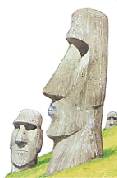 xxxxxIn the meantime Cook, after making another unsuccessful attempt to penetrate the Antarctic, returned again to the South Seas. Here he chartered Easter Island and Tonga, sighted some of the "Cook" and Hawaiian islands, visited Tahiti and the Marquesas Islands, and then, making for New Zealand, discovered the New Hebrides, New Caledonia and Norfolk Island. On his return journey home, he rounded Cape Horn and discovered South Georgia and the South Sandwich Islands in the South Atlantic. He then turned north, calling in at Cape Town on his way to England.
xxxxxIn the meantime Cook, after making another unsuccessful attempt to penetrate the Antarctic, returned again to the South Seas. Here he chartered Easter Island and Tonga, sighted some of the "Cook" and Hawaiian islands, visited Tahiti and the Marquesas Islands, and then, making for New Zealand, discovered the New Hebrides, New Caledonia and Norfolk Island. On his return journey home, he rounded Cape Horn and discovered South Georgia and the South Sandwich Islands in the South Atlantic. He then turned north, calling in at Cape Town on his way to England.
xxxxxThis epic voyage (see map below), lasting three years and covering some 60,000 miles, not only discovered new islands across the South Pacific and in the South Atlantic, but finally disproved the existence of a "southern continent", -
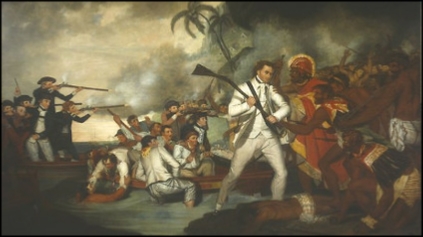 xxxxxHis third and what proved to be his final voyage to the South Seas was made in an attempt to find a Northwest Passage between the Pacific and Atlantic oceans, north of Alaska and Canada. Promoted to captain, he sailed again on the Resolution, setting out in July 1776. He was joined by the Discovery at the Cape of Good Hope, and from here they visited Tahiti and went on to discover Christmas Island and the Sandwich Islands (later renamed the Hawaiian Islands). Then, having reached the west coast of North America, Cook stayed a month at Nootka Sound, near Vancouver, before sailing northwards and making a continuous survey of the coastline as far as the Bering Strait. Here, however, the way was blocked by thick ice, and the ships had to turn back. Nonetheless, Cook was the first to see both sides of the strait and thus prove that Asia and America were two separate continents. In travelling south, he sailed along the coast of Asia, surveying the coast of Siberia as he went. The expedition then made for the Hawaiian Islands and it was here, in February 1779, that Cook and four members of his crew were killed in a skirmish with the islanders over the theft of a boat (illustrated). The captain's bones were eventually recovered (the flesh had been burnt) and they were committed to the deep. The expedition then made for home.
xxxxxHis third and what proved to be his final voyage to the South Seas was made in an attempt to find a Northwest Passage between the Pacific and Atlantic oceans, north of Alaska and Canada. Promoted to captain, he sailed again on the Resolution, setting out in July 1776. He was joined by the Discovery at the Cape of Good Hope, and from here they visited Tahiti and went on to discover Christmas Island and the Sandwich Islands (later renamed the Hawaiian Islands). Then, having reached the west coast of North America, Cook stayed a month at Nootka Sound, near Vancouver, before sailing northwards and making a continuous survey of the coastline as far as the Bering Strait. Here, however, the way was blocked by thick ice, and the ships had to turn back. Nonetheless, Cook was the first to see both sides of the strait and thus prove that Asia and America were two separate continents. In travelling south, he sailed along the coast of Asia, surveying the coast of Siberia as he went. The expedition then made for the Hawaiian Islands and it was here, in February 1779, that Cook and four members of his crew were killed in a skirmish with the islanders over the theft of a boat (illustrated). The captain's bones were eventually recovered (the flesh had been burnt) and they were committed to the deep. The expedition then made for home.
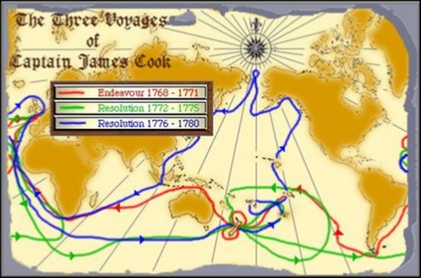 xxxxxQuite apart from Cook's extraordinary ability in seamanship, navigation, cartography and hydrography -
xxxxxQuite apart from Cook's extraordinary ability in seamanship, navigation, cartography and hydrography -
xxxxxIncidentally, William Bligh of Mutiny on the Bounty fame was sailing master of the Resolution on Cook's final voyage, and the explorer George Vancouver served with Cook on his second and third expeditions. ......
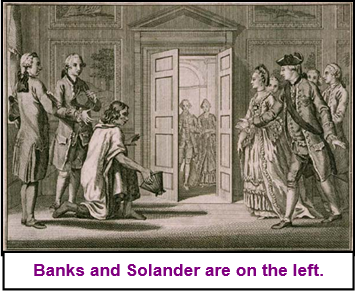 xxxxx...... OnXhis return to England, Tobias Furneaux (1735-
xxxxx...... OnXhis return to England, Tobias Furneaux (1735-
xxxxx…… ThexLondon-
Acknowledgements
Cook: detail, by the English portrait painter Nathaniel Dance-
G3a-
Including:
William Hodges,
Joseph Banks, and
Louis Antoine de Bougainville

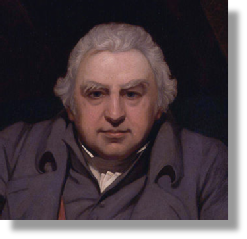 xxxxxThe English naturalist Joseph Banks (1743-
xxxxxThe English naturalist Joseph Banks (1743-
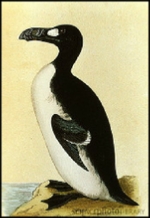
xxxxxBanks was born in London of a wealthy land-
xxxxxHe was appointed president of the Royal Society in 1778 and held this office for 42 years. It was as a result of his friendship with George III that the Royal Botanic Gardens at Kew were extensively developed. Under his directorship it became a major centre of botanical research. He also played a part -
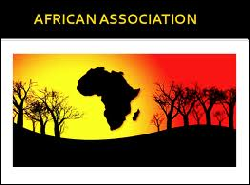 xxxxxAndxit was through Banks’ initiative that the African Association came about. Formed at a meeting in London in 1788, it aimed to promote the discovery of the interior parts of Africa and, to a large extent, marked the beginning of the age of African exploration. It was motivated by worthy intentions -
xxxxxAndxit was through Banks’ initiative that the African Association came about. Formed at a meeting in London in 1788, it aimed to promote the discovery of the interior parts of Africa and, to a large extent, marked the beginning of the age of African exploration. It was motivated by worthy intentions -
xxxxxIncidentally, Banksxwas accompanied on his voyage to the South Seas by his assistant, the Swedish botanist Daniel Solander (1736-
…..…
Xxxxx…..… It appears that Banks placed a price on his services. The story goes that he refused to go on Cook’s second voyage because he was not allowed to take two horn players to play for him during dinner! As a result, thexbotanists on Cook's second voyage were the German scientists Johann and Georg Forster, father and son. In addition to collecting botanical specimens they also observed climatic changes. In 1777 Georg published his A Voyage Round the World, based mainly upon his father's journals.
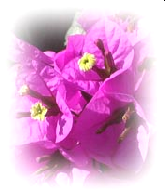 xxxxxThe first Frenchman to circumnavigate the globe was the explorer Louis Antoine de Bougainville (1729-
xxxxxThe first Frenchman to circumnavigate the globe was the explorer Louis Antoine de Bougainville (1729-



